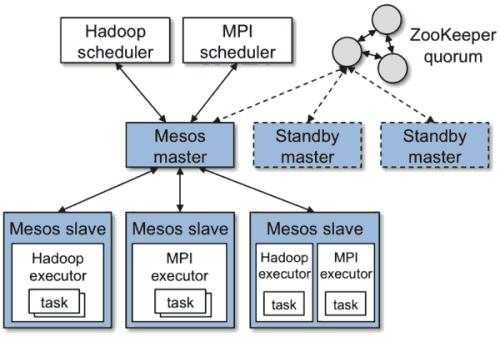(1) Background: Container orchestration frameworks provide support for management of complex distributed applications. Different frameworks have emerged only recently, and they have been in constant evolution as new features are being introduced. This reality makes it difficult for practitioners and researchers to maintain a clear view of the technology space. (2) Methods: we present a descriptive feature comparison study of the three most prominent orchestration frameworks: Docker Swarm, Kubernetes, and Mesos, which can be combined with Marathon, Aurora or DC/OS. This study aims at (i) identifying the common and unique features of all frameworks, (ii) comparing these frameworks qualitatively and quantitatively with respect to genericity in terms of supported features, and (iii) investigating the maturity and stability of the frameworks as well as the pioneering nature of each framework by studying the historical evolution of the frameworks on GitHub. (3) Results: (i) we have identified 124 common features and 54 unique features that we divided into a taxonomy of 9 functional aspects and 27 functional sub-aspects. (ii) Kubernetes supports the highest number of accumulated common and unique features for all 9 functional aspects; however, no evidence has been found for significant differences in genericity with Docker Swarm and DC/OS. (iii) Very little feature deprecations have been found and 15 out of 27 sub-aspects have been identified as mature and stable. These are pioneered in descending order by Kubernetes, Mesos, and Marathon. (4) Conclusion: there is a broad and mature foundation that underpins all container orchestration frameworks. Likely areas for further evolution and innovation include system support for improved cluster security and container security, performance isolation of GPU, disk and network resources, and network plugin architectures.
翻译:(1) 背景:集装箱带宽框架为复杂分布式应用程序的管理提供支持,不同框架只是最近才出现,随着新特点的出现而不断演变,这种现实使得从业者和研究人员很难保持对技术空间的清晰了解。 (2) 方法:我们对三个最突出的管宽框架:Docker Swararm、Kubernetes和Mesos进行了描述性特征比较研究,这些框架可以与马拉松、Aurora或DC/OS相结合。这项研究的目的是:(一) 查明所有框架的共同和独特特点,(二) 从质量和数量上比较这些框架的成熟性特征的通用性,以及(二) 从质量和数量上比较这些框架的成熟性能,(三) 通过研究GitHub框架的历史演变,调查框架的成熟性和稳定性和稳定性。 (3) 成果:(一) 我们确定了124个共同特征和54个独特特征,这些特征可以分为9个功能方面和27个功能类子。 (二) Kubernetes支持所有9个功能级的累积性共同和独特特性的成熟性框架,以及稳定性和稳定性基础基础,但是,没有多少证据表明,在Swase 和稳定性的网络的稳定性和稳定性和稳定性方面有显著的特征和稳定性的特征上的差异。




